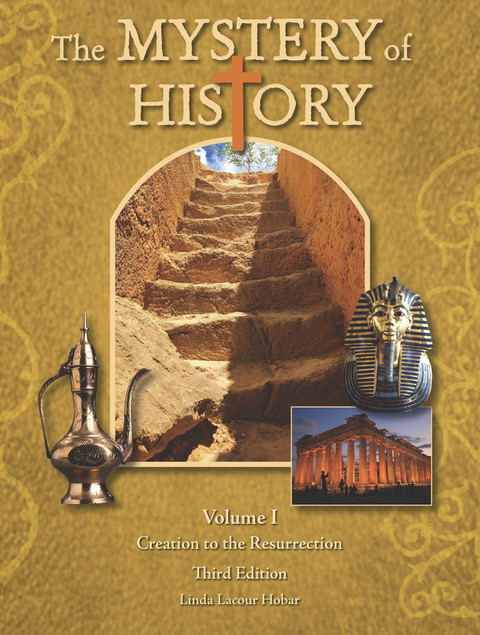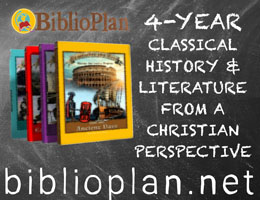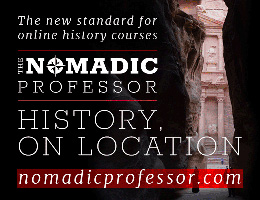The Mystery of History series is designed so that even inexperienced parents can break free from traditional textbooks. These four courses combine read-aloud information with age-appropriate activities for kindergarten through twelfth grade to create a multi-sensory curriculum for history and geography with a very strong biblical base. The first two volumes are best for the younger end of the K-12 spectrum even though the independent reading level for Volume I is about fourth or fifth grade. The reading level gradually advances with each volume. Parents will be reading aloud with younger children, and the storytelling-style of writing makes the material more accessible than you would expect for younger students. Many activities and suggestions are included to adapt every volume to the entire K-12 age span, but the last two volumes are definitely better for older students.
Titles for the four courses are:
- Volume I: Creation to the Resurrection
- Volume II: The Early Church and the Middle Ages (A.D. 30-1460)
- Volume III: The Renaissance, Reformation, and Growth of Nations (1455-1707)
- Volume IV: Wars of Independence to Modern Times (1708-the present)
All four courses present the material in a hardcover reader and a Companion Guide. A code for a free digital download of the Companion Guide is included with each reader. (Print versions of the Companion Guides for Volumes I, II, and III are available at extra cost.) The readers are attractively designed, hardcover books with full-color illustrations. The Companion Guides each have 500 to 600 black-and-white pages for pre-tests, post-tests, activities, maps, projects, and assignments.
A number of supplemental items are available that correlate with each volume of Mystery of History.
- Audio CDs or MP3 files - recordings of all stories in a volume read aloud by the author to the accompaniment of appropriate background music. This is a great time saver for busy parents, and it might be especially helpful for those children who like to hear the stories more than once. These will eventually be available for the first volume as well.
- History Through the Ages timeline figures
- Coloring pages - downloadable PDFs that correlate with lessons
- Challenge Cards - Q & A cards for reviewing course content
- Notebooking pages - PDF pages for either younger or older students
- Folderbook files for creating a folderbook for each quarter of a course (This is a project book like a lapbook.)
The Challenge Cards, coloring pages, notebooking pages, and folderbook files are packaged together for each volume as a Super Supplemental Collection, or they can be purchased individually from the author's website. The audio recordings and timeline figures must be purchased individually.
The curriculum includes a great deal of map work. Map activities in all four volumes require either printed atlases or WonderMaps (from Bright Ideas Press). WonderMaps is a customizable collection of over 350 different maps available as downloadable PDF files. As an alternative to WonderMaps, you can use the Rand McNally Historical Atlas of the World and the Student Bible Atlas by Tim Dowley with Volume I and the Rand McNally World Atlas: Know Geography and the Rand McNally Historical Atlas of the World with the other three volumes.
Lesson Structure
Each volume is structured for a school year with four quarters. Lessons are arranged in sets of three with the expectation that you will complete three per week. Each quarter begins with “Around the world” background and introductory information that you will want to read aloud with your children. Each week includes a pretest designed to spark interest, so you want to present these in a light-hearted fashion (like a Trivial Pursuit® game) rather than as a test.
Three lessons follow, each with a similar format: read-aloud information is presented from the book then you choose an activity for each child to complete. An activity is given for each of three levels, identified as younger, middle, and older. For example, the lesson on Noah in Volume I suggests that younger children play a Concentration card game. Middle to older students might use their Bibles to find answers to a list of questions regarding the account of the Flood. Older students might instead tackle the third option, which requires research about the supplies needed on the ark for Noah, his family, and all the animals.
At the end of every third lesson is a reminder for students to create Memory Cards—one per lesson. These are 3” x 5” notecards on which students will write a brief summary of the main idea of the lesson. (Parents will assist younger children.) These are used for oral drill, games, or independent review. (If you don't want students to create these, you can substitute the optional Challenge Cards for review purposes.)
More activities are included at the end of every third lesson, sometimes including field trip suggestions. Activities include work on a timeline, map work (with reproducible maps included), hands-on projects, games, research, writing, and more. Alternating each week for review purposes are "What Did You Miss?" and "What Did You Learn?" The "What Did You Miss?" activity is a puzzle, game, or exercise, while "What Did You Learn?" is a quiz. Complete answer keys are at the end of each Companion Guide. These include images of completed mapwork.
The Companion Guide has extensive suggestions for creating a timeline or a timeline notebook. The timeline-creation process can be as simple or complex as you wish.
Near the front of the Companion Guide, author Linda Hobar explains how to select activities and make assignments for students working at different levels. Younger children will spend more time working one-on-one with a parent. They have more arts-and-crafts type activities that are not graded. Older students do more independent reading, research, and writing that is graded. Suggestions for additional reading are included in an appendix titled Supplemental Books and Resources. This is a large list of books and videos that expand upon topics, and it is presented lesson by lesson and broken down by age levels.
All of this can be scheduled as best suits your family. A number of possible scheduling suggestions for different levels are found near the beginning of each Companion Guide.
Volume I: Creation to the Resurrection
Volume I has lessons for 36 weeks. It relies heavily on scripture since the Bible is a source for much of what we know about ancient times. Other than that, the historical information is all presented within this book as it would be in a textbook. Aside from the atlases or WonderMaps, no other reference works are required for this study unless older students are pursuing research activities.
Beginning with creation, the study follows biblical history, incorporating other sources as they fit into the chronological story. Thus, Stonehenge, early Egypt, and the Minoans are taught before Abraham, Jacob, and Joseph. The little we know about ancient world civilizations is represented by the inclusion of lessons such as those on Chinese dynasties, India and Hinduism, and early Greek city-states up to the point where the historical record broadens and we have more sources for learning about early civilizations. Although eastern civilizations are given some attention, the focus is much stronger on western civilizations.
While this is essentially a study of history, it is also a Bible study of sorts with an apologetic flavor in spots. Near the end of the Volume I: Student Reader is an adaptation of Campus Crusade’s booklet used for leading people to accept Christ. A letter to students at the beginning of that book directs students to it if they don’t already have a relationship with God.
Volume II: The Early Church and the Middle Ages
In the second volume, the biblical chronology concludes after the first few weeks of the course. There are 28 weeks' worth of lessons. This is fewer lessons than in Volume I, but each lesson has more content.
Hobar’s selection and presentation of topics are fascinating. Given the huge time period she covers in Volume II, she does a great job of pulling out key people and events so students get the big picture. For example, topics for the second and third weeks of the course are Nero, Martyrs of the Early Church, Josephus, Masada, The Dead Sea Scrolls, and The Buried City of Pompeii. While the primary emphasis is on the development of western civilization, there are quite a few lessons on Japan, China, Iceland, New Zealand (focusing on the Maori), Africa (focused on the city Great Zimbabwe), the Aztecs, and the Inkas.
For Volume II, there is an optional cookbook available through the author's website.
Volumes III and IV
Both Volumes III and IV present lessons for 28 weeks, but it might take longer than that to complete them. The readers for Volume III and Volume IV have more text than Volume II and significantly more than Volume I. Hobar says the target audience for Volume III is primarily grades four and up, but Volume III seems to me best for grades seven through twelve simply because of the breadth and depth of information covered. Volume IV was written for grades seven through twelve but seems especially good for high school. As author Linda Hobar notes in the preface to the Student Reader, its coverage of wars and philosophy makes it inappropriate to include younger students in a number of lessons.
Keep in mind that the writing style is very engaging, and this certainly helps to offset difficulty in the level or amount of content. Occasionally, the author suggests that younger or middle students stop reading at a certain point and that older students continue with material that is deeper or more detailed. Lessons with particularly sensitive content include a note to the teacher at the beginning of the lesson or segment, so you won’t be caught off guard. This helps, but ultimately parents have to decide how much of the material to cover with each student.
All students should participate in the age-appropriate activities suggested in the Companion Guides—there are plenty of activities! Recommendations for appropriate books to read are also in the Companion Guides, and you might rely more heavily upon them with younger students.
Even given the amount of material in the readers, Hobar says that high school students should be reading additional books and primary source material from the extensive "Supplemental Books and Resources" sections of the Companion Guides. The combination of reading and activities for Volume III’s core curriculum should take about one to three hours per week to complete, and Volume IV should take a bit more time. For high school credit, students should generally be spending four to five hours per week. To fulfill any hours requirement, students might also tackle a research paper or a number of shorter reports. Assignments already in the guides can easily be expanded into lengthier assignments, and some suggestions for this are provided in the guides.
Keep in mind that high school students will need to complete a separate U.S. history course. If you need to condense Mystery of History courses, you might skip some chapters, especially chapters in Volume IV that duplicate material in your U.S. history course.
Volume III covers the time period of the Reformation. Although Hobar does a better than average job of trying to present the Catholic side of issues, such as indulgences, the content is strongly Protestant.
Volume IV teaches modern history under four "war" themes: Wars of Independence, Wars of Ideologies, Wars of the World, and Wars of Modern Times and the Hope of Mankind. In spite of these organizing themes, the course covers many other topics regarding culture and religion. Selected historical figures are highlighted such as Voltaire, Benjamin Franklin, Hudson Taylor, Helen Keller, Martin Luther King Jr., Mother Teresa, Billy Graham, and Nelson Mandela.
Summary
This combination of multi-sensory activities and self-contained history that can be used to teach more than one grade level at a time should be very appealing to many homeschooling families.


















